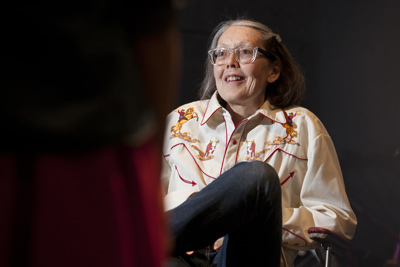Renowned poet Anne Carson leads workshop on collaboration
By Joyanna Gilmour

How would you perform the idea "container?" A small group of Cornell students recently did it by standing in a circle. One by one, they made a noise and repeated it until together they were "containing" the sounds.
It was one of several exercises led by Anne Carson, an acclaimed Canadian poet, essayist, translator and A.D. White Professor-at-Large, as part of a multimedia workshop on collaboration called EGOCIRCUS. About 15 students took part in the workshop Feb. 13-15, where they studied different kinds of collaboration as well as designed and produced their own work under the guidance of Carson and her collaborator Robert Currie.
The workshop was offered through Cornell's Department of Theatre, Film and Dance and took place at the Black Box Theatre in the Schwartz Center for the Performing Arts.
Carson, a professor of classics and comparative literature at the University of Michigan, focuses her work on synthesizing different types of literature, including poetry, essay, dramatic dialogue and mythology. She has won such prestigious awards as the Pushcart Prize (1997), the Guggenheim Fellowship (1998) and the MacArthur Fellowship (2000).
Although EGOCIRCUS focused on collaborative multimedia, such as dance, video and music, the goal was to improve the students' writing.
"We make students learn things, or use things that they already know, that will make them better writers. It's a different way of making people write," said Currie.
Students were split into small groups to work on multimedia exercises, reminiscent of charades, where they were given an idea and a limited amount of time to come up with a way to represent it. They were allowed to incorporate any available props as well as physical movement, spoken word and musical sounds into their collaborations.
In one exercise, the participants were divided into two groups and were instructed to create a collaborative skit based on the idea of either "containment" or "container." Each group then performed the skit for the other before joining together to create another skit combining these ideas.
Another exercise consisted of "duets," where students split into groups of two and spent one minute developing a multimedia skit to represent such ideas as "pirate," "nickname" and "haircut." Between exercises, Carson and Currie gave constructive feedback to the participants and shared from their own experiences in collaborative multimedia productions.
Students in the workshop will present a free collaborative performance, using techniques and methods from the workshop, Friday, Feb. 17, at 7:30 p.m., in the Schwartz Center. At the event, Carson and Currie will also present "Bracko," a multimedia recitation of poetry by Sappho in four voices with accompanying video. The performance includes "Cassandra Float Can," Carson's multimedia lecture on translation.
Also during her visit, Carson gave a short lecture titled "Contempts," a study of profit and nonprofit in the works of Homer, Alberto Moravia and Jean-Luc Godard, Feb. 16 in Willard Straight Theatre, before a free screening of Godard's 1963 film "Contempt" ("Le Mepris").
This is the first time Carson has visited Cornell as part of the Andrew D. White Professors-at-Large program. The professors are a group of approximately 20 distinguished academics who are appointed as nonresident professors for six years. The program was a brainchild of Cornell co-founder Andrew White, who had a vision to regularly bring the world's foremost scholars and artists to the Ithaca campus. Professors-at-large visit Cornell for about a week every three years.
Graduate student Joyanna Gilmour is a writer intern for the Cornell Chronicle.
Media Contact
Get Cornell news delivered right to your inbox.
Subscribe